Customer Logins
Obtain the data you need to make the most informed decisions by accessing our extensive portfolio of information, analytics, and expertise. Sign in to the product or service center of your choice.
Customer Logins
ECONOMICS COMMENTARY
Dec 05, 2016
PMI surveys show global economy on course for best quarter of the year
The global economy is enjoying its strongest quarter so far this year, according to PMI survey data, though cost inflationary pressures have also intensified to a near- three year high.
The JPMorgan Global PMI, compiled by Markit from its various national surveys, held steady in November, unchanged on October's 11-month high of 53.3. The improvement means that the PMI signals annual global GDP growth (at market prices) accelerating towards 2.5% in the fourth quarter, breaking through the 2% barrier for the first time this year.
Global economic growth
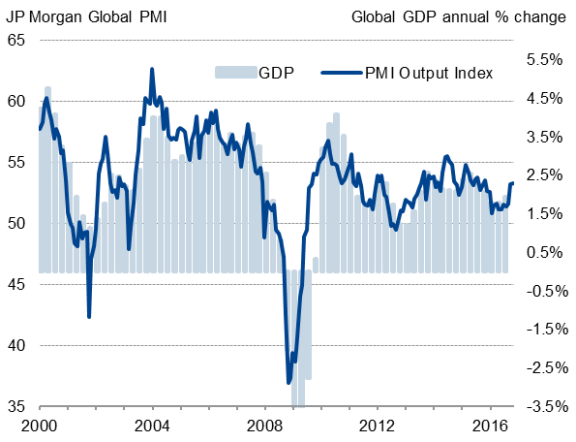
Robust growth was recorded in both manufacturing and services, suggesting a broad-based improvement in the global economy by sector . However, the developed world continued to outpace the emerging markets, continuing the trend that has been seen almost continually over the past three years.
Developed v emerging market PMI (output)
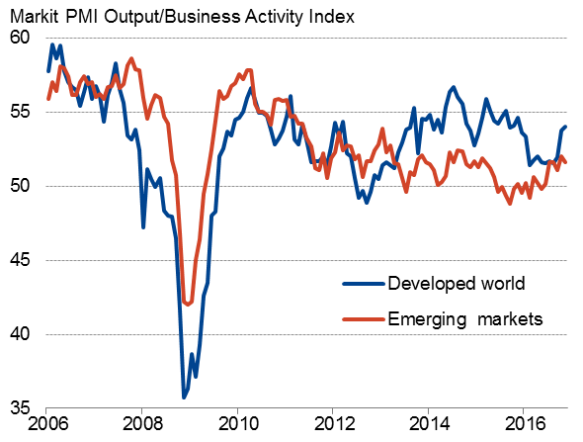
While business activity growth in the developed world accelerated to a 12-month high, the pace slowed in the emerging markets. The latter are nevertheless on course for the strongest quarterly performance just over two years and would have seen stronger growth had business activity in India not been disrupted by the withdrawal of high value bank notes.
Global manufacturing v services PMI (output)
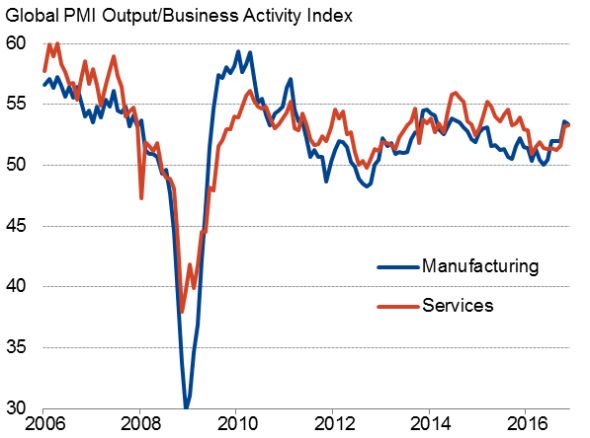
Sources for charts: IHS Markit, JPMorgan, Nikkei, Caixin.
Modest hiring
Inflows of new business rose globally at the fastest rate for a year, though levels of outstanding business increased only very marginally, suggesting demand is not growing at a rate which is generating capacity constraints. Employment consequently rose only modestly again, albeit showing the strongest rise for nine months by a small margin.
Price pressures near three-year high
Faster economic growth was again accompanied by rising inflationary pressures. Companies' input costs increased at the fastest rate since January 2014, linked mainly to higher global commodity prices (notably oil and energy).
Average prices charged for goods and services also rose, but the increase was only very modest and weaker than recorded in October, attributable to weaker price growth in the service sector.
Developed world
Growth was broad-based across the major rich-world economies.
Developed world output
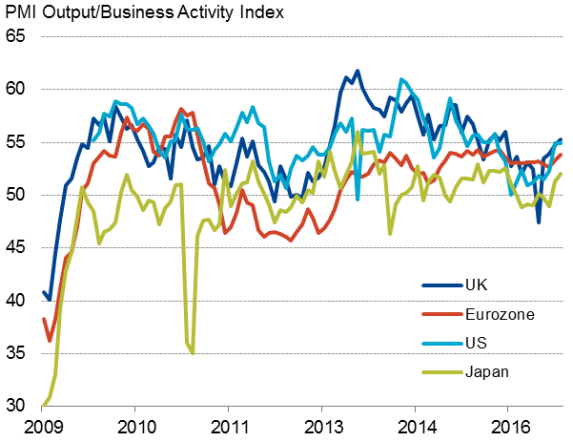
US growth held steady at October's 11-month high, the surveys running at a level consistent with 0.6% (2.5% annualised) GDP growth. A surge in manufacturing growth to a 20-month high offset a mild slowing in services, though even the latter showed robust expansion, with both sectors benefitting primarily from stronger domestic demand.
Eurozone growth meanwhile accelerated to the fastest since December 2015, suggesting the pace of economic growth will pick up to 0.4% in the fourth quarter. The surveys highlighted how the weak euro helped boost manufacturing, while services also enjoyed its best expansion so far this year.
UK companies continued to report solid expansion, with the rate of growth hitting the highest since January. The surveys signal 0.5% GDP growth in the closing quarter of 2016, suggesting resilient business growth in the face of ongoing Brexit-related uncertainty.
Japan also saw growth accelerate, with the PMI surveys registering the strongest expansion since January. A manufacturing sector upturn, fuelled in part by export gains arising from the weaker yen, was accompanied by signs of faster service sector growth.
Emerging markets
Emerging market trends were mixed. Growth held steady at a robust three-and-a-half year high in China, with stronger services growth indicating that the country continues to rebalance towards the tertiary sector. Manufacturing also continued to expand, albeit with growth crimped by stagnant exports.
Emerging markets output
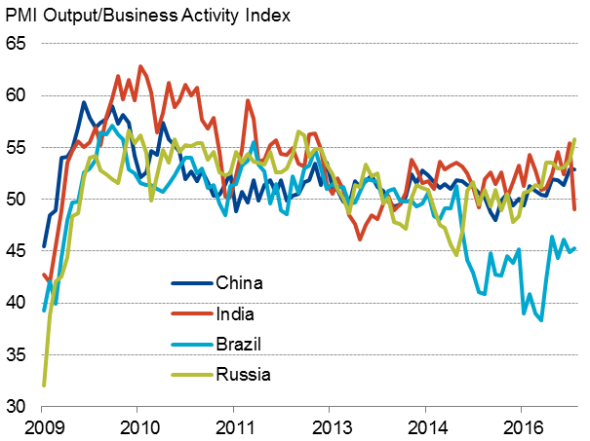
Sources for charts: IHS Markit, Nikkei, Caixin.
However, the strongest expansion among the BRICs was seen in Russia, where the surveys indicated the strongest monthly rise in business activity for four years. Both services and manufacturing saw faster growth, the latter picking up in spite of falling exports.
Business activity meanwhile fell in India for the first time in almost one-and-a-half years, as a steep fall in services activity countered sustained growth in manufacturing. The drop in services output was widely linked to the withdrawal of high-denomination bank notes. Importantly, optimism about the outlook improved.
But it was Brazil that continued to record the steepest downturn. That said, the rate of decline eased slightly in November, and has at least moderated compared to earlier in the year in both manufacturing and services.
Chris Williamson | Chief Business Economist, IHS Markit
Tel: +44 20 7260 2329
chris.williamson@ihsmarkit.com
{"items" : [
{"name":"share","enabled":true,"desc":"<strong>Share</strong>","mobdesc":"Share","options":[ {"name":"facebook","url":"https://www.facebook.com/sharer.php?u=http%3a%2f%2fwww.spglobal.com%2fmarketintelligence%2fen%2fmi%2fresearch-analysis%2f05122016-Economics-PMI-surveys-show-global-economy-on-course-for-best-quarter-of-the-year.html","enabled":true},{"name":"twitter","url":"https://twitter.com/intent/tweet?url=http%3a%2f%2fwww.spglobal.com%2fmarketintelligence%2fen%2fmi%2fresearch-analysis%2f05122016-Economics-PMI-surveys-show-global-economy-on-course-for-best-quarter-of-the-year.html&text=PMI+surveys+show+global+economy+on+course+for+best+quarter+of+the+year","enabled":true},{"name":"linkedin","url":"https://www.linkedin.com/sharing/share-offsite/?url=http%3a%2f%2fwww.spglobal.com%2fmarketintelligence%2fen%2fmi%2fresearch-analysis%2f05122016-Economics-PMI-surveys-show-global-economy-on-course-for-best-quarter-of-the-year.html","enabled":true},{"name":"email","url":"?subject=PMI surveys show global economy on course for best quarter of the year&body=http%3a%2f%2fwww.spglobal.com%2fmarketintelligence%2fen%2fmi%2fresearch-analysis%2f05122016-Economics-PMI-surveys-show-global-economy-on-course-for-best-quarter-of-the-year.html","enabled":true},{"name":"whatsapp","url":"https://api.whatsapp.com/send?text=PMI+surveys+show+global+economy+on+course+for+best+quarter+of+the+year http%3a%2f%2fwww.spglobal.com%2fmarketintelligence%2fen%2fmi%2fresearch-analysis%2f05122016-Economics-PMI-surveys-show-global-economy-on-course-for-best-quarter-of-the-year.html","enabled":true}]}, {"name":"rtt","enabled":true,"mobdesc":"Top"}
]}




